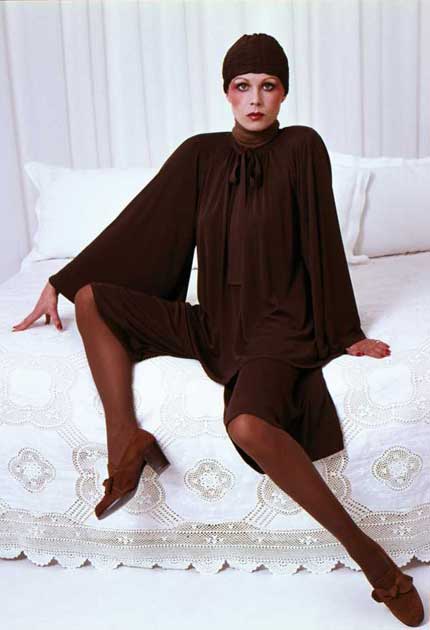Jean Muir: a fashion icon, National Museum of Scotland, Edinburgh
When dressmaking was 'painting in cashmere'

Had had she not been a fashion designer Jean Muir claimed she would have loved to have been a dancer. You can see that in the theatrical style and flowing fabrics of the clothes in an exhibition that exudes her characteristic elegance. Designed to skim flatteringly over the body in the way they move, these costumes – with their fluid silhouettes and sophisticated swirls – take on a life of their own.
Just 30 finished garments and accessories, along with sketches, intriguing pieces of patterns, toiles or trial garments and swatches of fabric as well as a glimpse into Muir's production process, are on display in Jean Muir: A Fashion Icon.
When Muir's widower and business partner Harry Leuckert donated the Jean Muir archive to the National Museum of Scotland four years ago, staff counted 18,000 items, making it the biggest archive of a fashion designer anywhere in the world. The collection – dating from 1966 until Muir's death in 1995 – will eventually form an educational resource at the museum's centre on the waterside at Granton.
Walking around the exhibition is like delving into an endless and very high-quality dressing-up drawer. Only you can't touch, of course. And that is the irresistible temptation when faced with these tactile materials – matte jersey, wool crepe, suede, leather and knitwear – the seductive signature fabrics from her work under the Jane & Jane label and later Jean Muir Ltd.
Muir knew what she was talking about when she described what she did as "engineering with cloth". The precision and perfectionism she applied is as evident in a printed leather jacket as in a set of comical cow buttons from 1972 inspired by the sight of grazing cattle. Muir was enormously proud of her Scottish heritage and did much to support the country's wool industry from her design house on London's Bruton Street. She also saw her work as "painting in cashmere", evident in the vibrant dots and dashes knitted and chain-stitched into one piece ,and the quirky sweater dress of 1989 based on the shape and colours of an artist's palette.
Considering Muir's strict adherence to "any colour as long as it's navy blue", it's a surprise to find so much ravishing colour here, not just in subtle detail or wacky accessories but in whole outfits drawn from her vibrant Australian bicentennial collection of 1988.
Inspired by the Great Barrier Reef and paraded across the stage of the Sydney Opera House, they include a star hat, barnacle brooches, an astonishing felt coat that reeks of salt water and a sweater with fish netted in it. A later abstract intarsia crevette sweater-dress was based on a prawn-themed item from the Australian collection. Muir claimed not to produce "young kooky fashions" but she certainly enjoyed injecting wit into her work. There's whimsy too in dragonfly patterns and homages to Pierrot.
It's easy to pick out the influence she had on some of today's designers including Manolo Blahnik and Issey Miyake. Those who swear by her cut include Claudia Schiffer, Sienna Miller. Lauren Bacall, Barbara Streisand and Diana Rigg, whose PVC catsuit Muir designed, among other of Rigg's costumes for The Avengers. The voice of Joanna Lumley follows you round the exhibition in an audio clip from No Room for Secrets in which the actress reminisces about her experiences as a house model for Muir. She goes so far as to declare that her favourite Muir dress "transformed her life utterly".
Video footage from the 1990s shows Muir at work and reinforces the iconic image of the plain bobbed hair, simple dark dress, chalky make-up and russet lipstick – of a woman who knew her own mind, learning her craft on the shop floor. A portrait by Norman Parkinson shows her posing with other top British fashion designers of swinging London, including Mary Quant. For Muir, "fashion" was a verb and, as curator Kristina Stankovski demonstrates, she fashioned herself seamlessly to the top of the British design and dressmaking industry.
To 15 March. National Museum of Scotland Chambers St, Edinburgh. Then at the National Museum of Costume, Dumfries 3 April-31 October
Subscribe to Independent Premium to bookmark this article
Want to bookmark your favourite articles and stories to read or reference later? Start your Independent Premium subscription today.

Join our commenting forum
Join thought-provoking conversations, follow other Independent readers and see their replies